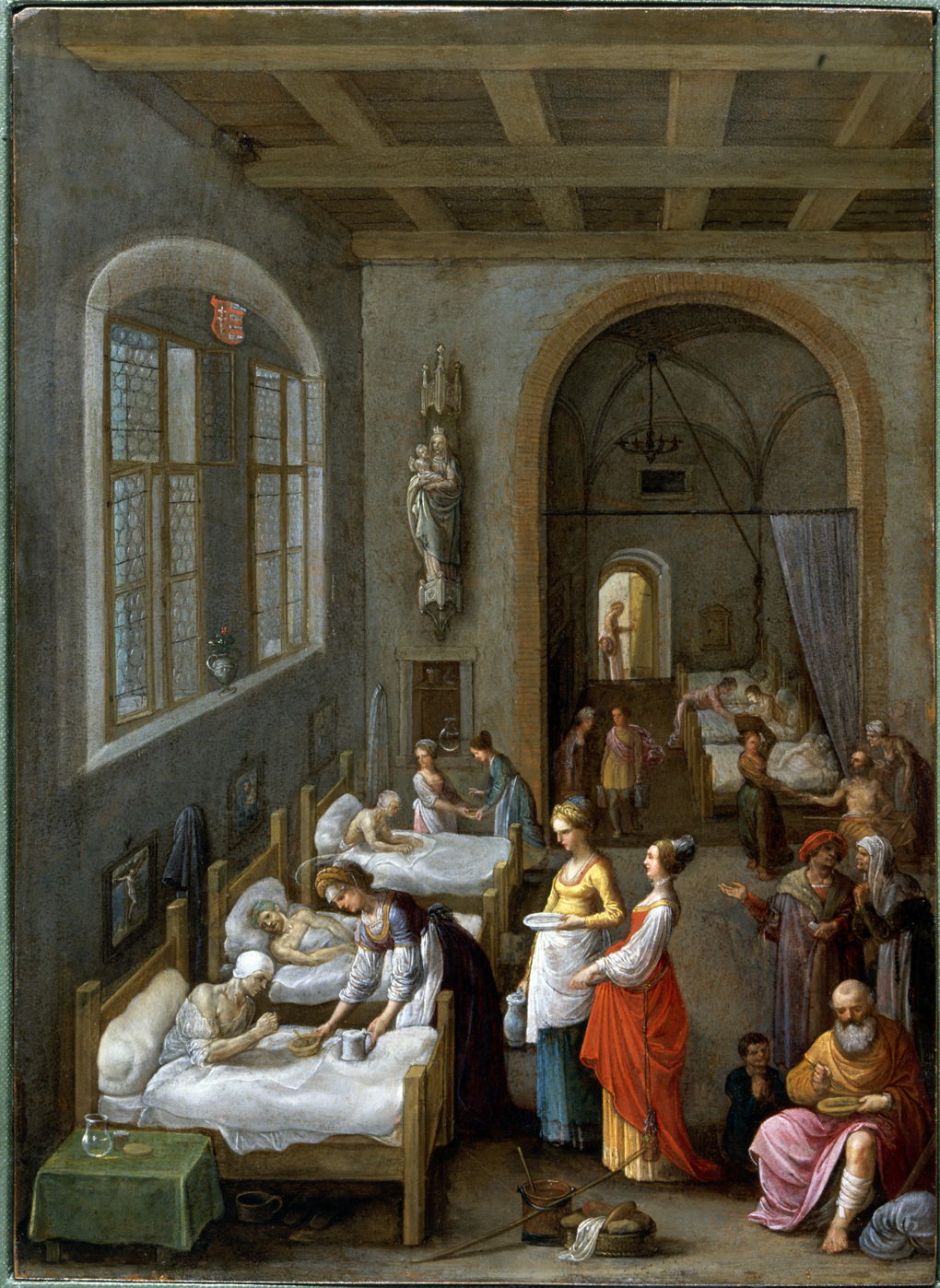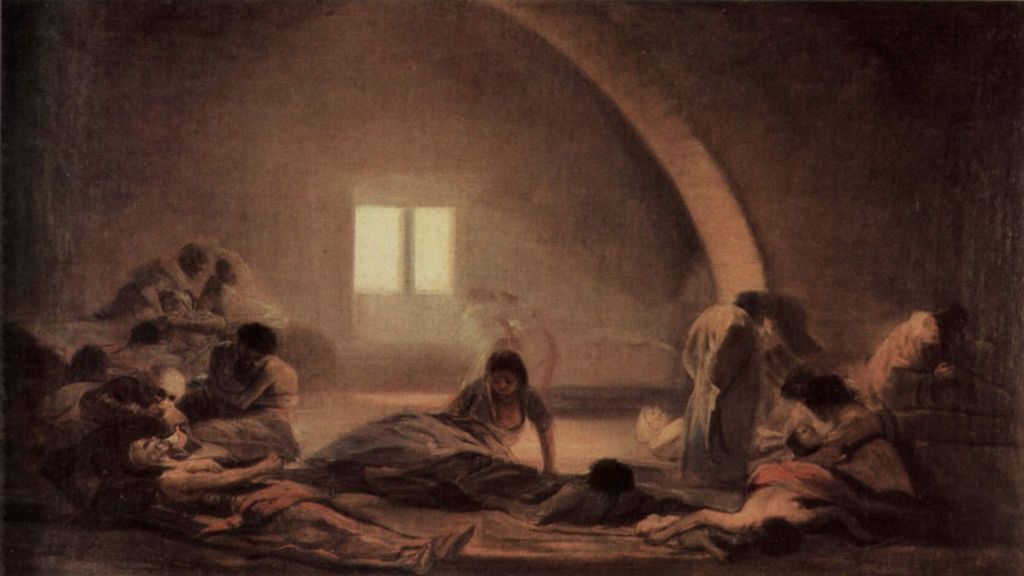The sick have traditionally been cared for by their families. But for those without families, particularly anyone away from home, there have long been charitable institutions and others prepared to offer hospitality. They could have been slaves in the Roman empire, soldiers in mediaeval Baghdad, those returning from the Crusades in Europe, or refugees crossing mountainous areas through passes.
Few early hospitals provided much in the way of medical care, which was generally expensive and ineffective in any case. Most were little more than large inns, and any care staff were usually members of religious orders. A few took in cases of transmissible diseases which had become proscribed locally – conditions such as leprosy, and plague – in an attempt to confine the disease and prevent spread. The richer you were, though, the greater the chance and desire of being nursed at home.

Jacopo Pontormo’s fresco showing an Episode from Life in Hospital from 1514 shows nuns from a religious order caring for other women, perhaps the sick from their own convent.

Venice was particularly prone to outbreaks of plague, and developed procedures and establishments for coping with cases. In Tintoretto’s painting of Saint Roch Heals Plague Victims from 1559, those suffering from plague have been brought to this small chapel, where the saint is healing them. The dark room is already collecting a disarray of bodies, some seemingly close to death. Without the miraculous work of the saint, this would quickly have become the waiting room for hell.

Adam Elsheimer shows a more positive atmosphere in Saint Elizabeth of Hungary Bringing Food for the Inmates of a Hospital from about 1598. Clearly run by a religious order or similar foundation, above each bed is a religious painting, and watching over them all is a statue of the Virgin Mary holding the infant Christ. Saint Elizabeth works with her halo visible, feeding the man in the bed nearest the viewer.

Some hospitals grew grand, such as that shown in Cornelis de Wael’s To Visit the Sick from about 1640. A team of doctors is gathered around a table to the left, where they write up their notes and directions for care. Extended families surround the few patients in their very modern iron beds, with children and dogs apparently welcome too.
But for many, hospitals remained a final resort, and they knew only too well that their chances of walking out alive were slim. This was even more true for hospitals which confined the mentally ill, the asylums.
In William Hogarth’s narrative series A Rake’s Progress, Bethlehem Hospital ‘for lunatics’ was the final stage in a saga which takes its lead actor Tom Rakewell from squandering his inheritance in orgiastic nights in brothels. After he recovers temporarily by marrying a rich but ugly old woman for her money, his descent continues through gambling until he is put into a debtor’s prison, where he becomes insane, and ends his days in the ‘Bedlam’ asylum.

Hogarth shows here a scene in London’s Bethlehem Hospital, given the common name of Bedlam, which has entered the English language. Tom is almost naked, tensed and stressed on the floor, with only an ignored friend to comfort him. Other inmates show the disturbing signs of their conditions, and two well-dressed ladies have come to watch the antics of those in Bedlam – a sign of the Enlightenment, it seems.

With the Age of Enlightenment came the first major voluntary hospitals, funded by benefactors, charities, and public subscription. Johannes Beerblock’s painting shows the very modern Wards of the Hospital of Saint John in the city of Bruges in 1778. Each bed was, in effect, its own private cubicle. There were trained medical staff, but nurses were compassionate carers rather than professionals.
In the centre, middle distance, a group of four elegantly-dressed physicians are doing the rounds of their patients. The main caring staff appear to be from a religious order, and wear its elaborate black-and-white uniforms. They are serving food, reading to comfort the sick and dying, and at the left are assisting a priest, perhaps in administering the last rites. Lay staff are cleaning and servicing the needs of patients.

At their worst, though, hospitals were still places of death and dread, as shown in Goya’s painting of a Plague Hospital from his disturbing series The Disasters of War (1808-10).
There were several big steps forward in transforming the hospital into something closer to those we have today. Most are associated with individuals, such as Louis Pasteur’s germ theory, Joseph Lister’s recognition of the importance of hygiene, and Ignaz Semmelweiss’s practice of anti-sepsis.

One of the most important revolutions is associated with the work of Florence Nightingale during the Crimean War. Although she is now a controversial figure, William Simpson’s illustration of One of the Wards in the Hospital at Scutari (Turkey) from 1856 gives an idea of the change which started in the middle of the nineteenth century.

American hospitals also saw great change at this time, some resulting from the Civil War. Jonathan Eastman Johnson’s painting of The Field Hospital (The Letter Home) from 1867 seems to refer back to that, its patient dictating a letter to his family from his camp bed.
In the late nineteenth century, as I will show in the next and concluding article, hospitals were transformed by the nursing revolution, the use of general anaesthesia for surgery, scientific advances in medicine, and more.

